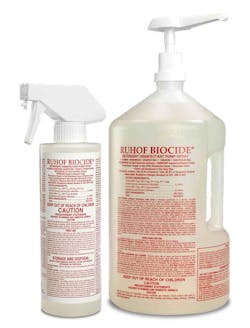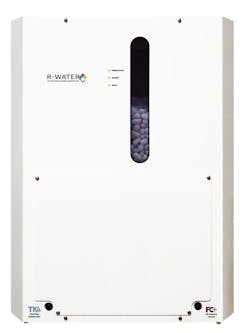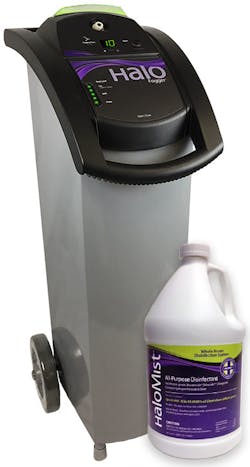While healthcare organizations have always been focused on reducing the risk of contamination and infections, whether it is dangerous microbes spread by high-touch surfaces, reuse of instruments that have not been properly cleaned/sterilized or other vectors, the COVID-19 pandemic highlighted the importance of safe and effective disinfecting practices. On top of usual efforts to keep patient care areas and equipment free from infectious organisms, stakeholders throughout healthcare are now tasked with additional protocols to stem the spread of SARS-CoV-2, the virus that causes COVID-19.
What follows are some useful tips from industry experts on evaluating the effectiveness of the variety of products used for disinfection of healthcare environments, as well as some of the latest product innovations in this area.
COVID-19: What works?
The COVID-19 pandemic has spurred the development of a wide range of products designed to help combat the virus. Healthcare providers are challenged with differentiating those solutions truly effective against SARS-CoV-2, versus those that are purely hype.
As Lowe explains, the top resource for identifying products that have been tested and shown to be effective against SARS-CoV-2 is the United States Environmental Protection Agency’s (EPA)’s List N: Disinfectants for Use Against SARS-CoV-2 (COVID-19). All of the products on the EPA’s List N meet the agency’s criteria for use against SARS-CoV-2, as well as products that meet other criteria, such as having demonstrated efficacy against viruses similar to or more difficult to kill than
SARS-CoV-2.
“It’s always useful to contact the manufacturer or check its website for disinfectants that the manufacturer lists as having EPA-approved kill claims against SARS-CoV-2,” Lowe added. “Additionally, healthcare professionals should always check the manufacturer’s website or product label for proper usage instructions.”
“As the coronavirus outbreak (COVID-19) continues to develop around the world we take our responsibility to support customers during crisis situations very seriously,” said Noreen Costelloe, Director of Marketing, Ruhof Corporation.
Types of disinfectants
There is a wide range of disinfectant methods used in hospitals today. In its Guideline for Disinfection and Sterilization in Healthcare Facilities (2008), the U.S. Centers for Disease Control and Prevention (CDC) lists common chemical disinfectants (e.g. alcohol, chlorine and chlorine compounds, formaldehyde, glutaraldehyde, hydrogen peroxide, peracetic acid, etc.), as well as other inactivating agents (e.g. ultraviolet radiation, pasteurization).
Effectiveness
While COVID-19 is front of mind for healthcare workers, they struggle every day to protect patients against a broad range of dangerous microorganisms; therefore, it is important to select a disinfectant with a broad spectrum of kill.
“Prior to February 2020, when the first COVID-19 infections were diagnosed, the primary, although not the only concern, were C. diff infections across all types of healthcare facilities,” said George Clarke, CEO of UMF Corporation. “The prior 10 to 12 months also had infection preventionists discussing and debating the role of biofilm. IC/IP and EVS should ensure that the disinfectant they use, whether it be chemical, UVC or electrostatic sprayer, or a combination of these technologies, be effective against C. diff endospores, Norovirus, MRSA, and any other organism of concern and also biofilm.”
Clarke points to the benefits of Klorkleen2, which is found on both the EPA’s N: List (COVID-19) and K: List (C. diff spores). He notes how Klorkleen2 is proven effective against a wide range of organisms, including bacterial spores, and is the only disinfectant with an EPA registered biofilm claim.
“The product comes in an effervescent tablet form registered with the EPA under the master label brand Klorkleen2 and available under a number of private label brands, including our own Klorese,” said Clarke. “The product has a long shelf life (in tablet form) and can be used throughout a facility, significantly reduces the storage footprint enabling hospitals and resellers to maintain significant inventory levels – for the next pandemic - in a fraction of the space required for most disinfectants. Additional cost benefits include reduced plastic waste and reduced shipping costs.”
Contact time
Time is of the essence in healthcare, with staff members challenged with caring for multiple patients and having to quickly and safely turnaround rooms and equipment. Therefore, selecting a disinfectant that can kill microbes quickly is a key consideration.
“People are searching for ways to save time in operations, such as reducing patient room turn times as patient loads have been so high,” said Rayne Guest, founder and CEO of R-Water. “One solution is to use products that have a shortened contact time and kill a wider range of germs so that facilities can move from two-step cleaning processes to a one-step process.”
“Infection Control will want to take into account contact time, the amount of time a product has to remain wet on a surface to be effective,” Guest added. “Liquid disinfectants generally have a 3-10-minute contact time. However, if the equipment is not water resistant, wipes should be used. Wipes generally have a contact time of 2-3 minutes. Many wipes may be needed to keep the surface wet for this duration. Otherwise germs will not be eliminated.”
Tami Heacock, MBA, CRCST, CHL, CNIM, ST, oneSOURCE Consultant and Manager at Wake Forest Baptist Medical Center, Winston Salem, notes how contact time is also an important consideration in the Central Sterile/Sterile Processing Department (CS/SPD), where staff members are challenged with reprocessing instruments quickly but safely.
“The CS/SPD area requires fast turnover times; a disinfectant with an extended dwell time will hinder a technician’s ability to serve his/her customers,” she said. “They should also follow the necessary instructions for use (IFU) to ensure every proper step is being taken to decontaminate and sterilize the instruments. I always recommend a platform like oneSOURCE to access the most updated and accurate IFUs because they are all housed in one central hub so you never miss anything.”
Creating the right mix
Beyond finding an effective and safe disinfectant to fight against SARS-CoV-2 or some other harmful microbe, healthcare professionals must also determine at what dilution it is effective for the intended purpose and mix the correct concentration.
“Many products degrade surfaces, ruin computer screens, and/or leave residue behind on equipment,” said Guest. “If products leave residues, the need to rinse is an extra burdensome labor step.”
Oberle recommends healthcare teams consider using a chemical management solution, such as a 3M Chemical Management System, “to take the guesswork out of mixing chemicals and help properly and easily dilute chemical concentrates every time.”
“In achieving accurate dilution, teams can save on chemical costs, while also mitigating labor costs associated with re-cleaning,” Oberle commented. “In addition to ensuring you are using the right type and amount of product, pre-cleaning and abiding by dwell times are also critical steps to more efficient and effective disinfection practices.”
Supply chain challenges
Disruptions in the global supply chain and the sharp and sudden demand for disinfectants during the COVID-19 pandemic have resulted in supply shortages, explains Clarke.
“The current COVID-19 pandemic caught most, if not all, hospitals unprepared as supplies of personal protective equipment (PPE), disinfectants and wipes quickly evaporated, and inventories were depleted with unpredictable lead times for replenishment,” he stated.
Heacock says the supply chain roadblocks caused by COVID-19 have made it even more challenging for healthcare facilities to procure disinfectants that are effective against a wide range of microorganisms, not only SARS-CoV-2, but other dangerous viruses, bacteria and other microbes commonly found in healthcare environments.
“Since the COVID-19 pandemic hit, obtaining disinfectants effective against a wide range of microorganisms, including the coronavirus, has become increasingly difficult,” she said. “Many hospitals have been forced to revert to manufacturing solutions themselves. Many of these solutions contain respiratory irritants that may cause discomfort to team members. The pandemic has also made it challenging to obtain the PPE necessary to mix and use the solutions needed to disinfect surgical instruments.”
R-Water has developed a device that enables healthcare workers to produce hundreds of gallons of hypochlorous acid, the active ingredient in bleach that does the killing, each day onsite. Unlike bleach, hypochlorous at a low ppm doesn’t cause lung irritation.
“Because COVID-19 is a respiratory illness, using disinfectants that don’t exasperate respiratory irritation is crucial,” said Guest. “In addition, a lot of people have sustainability goals in healthcare, so when you can produce products onsite, it helps achieve these goals by eliminating unnecessary deliveries and the disposal of cardboard and hazardous plastic waste. Producing disinfectant onsite also eliminates the need to procure, receive and store products, thus alleviating time-consuming tasks in materials management and other departments.”
Application options
Proper application of disinfectants is key to their effectiveness, and there are a variety of options on the market beyond the standard “spray and wipe” method. David St. Clair, Chairman and CFO, Halosil International, comments on a few of the available solutions.
“Other solutions, such as dry foggers, are dry by their very nature and can operate entirely in touchless mode, reaching all the nooks and crannies of an environment without leaving a sticky or wet residue,” St. Clair added. “This limits labor costs and exposure of cleaning staff all while mitigating concerns that disinfectants will damage costly equipment.”
“First, is claimed device efficacy validated by independent, third party laboratory testing? Second, are the claims for whole room disinfection supported by testing at real-world distances that correlate to whole room disinfection? Third, has the device’s effectiveness been proven in peer-reviewed published clinical studies? Last, does the manufacturer have a proven methodology to confirm that a germicidal dose has reached a target surface? Addressing these four simple questions can help healthcare professionals understand if a UV device is truly effective.”
Synexis has developed a biodefense system that uses patented technology to create the gas form of hydrogen peroxide, called Dry Hydrogen Peroxide or DHP. Kari L. Love, RN, MS, CIC, FAPIC, Program Director Infection Prevention, Office of Quality, Emory Healthcare, which uses the system, explains how the solution can reach even the most hard-to-reach spaces in a healthcare facility because it is a gas and can go wherever the air goes.
When asked for her advice to other facilities evaluating disinfectant modalities, Love stated: “When considering effective ways to battle common pathogens, healthcare facilities should consider holistic solutions that help reduce the bioburden in the air and on surfaces, but also in places other cleaning methods may not reach. It should be a flexible option that offers minimal labor and training needs.”
Attacking microbes through the air
According to the U.S. Environmental Protection Agency (EPA), there is growing evidence that SARS-CoV-2, the virus that causes COVID-19, can remain airborne for longer times and further distances than originally thought.2 The pandemic has heightened concerns around air quality in hospitals and other healthcare facilities, prompting them to implement technologies designed to combat microbes in the air.
One such solution is the UV Angel Clean Air Automated Continuous UV-C Air Treatment System, which uses patented UV-C light air purification technology to reduce levels of viruses, bacteria and fungi. Air is quietly drawn into a sealed UV-C air chamber with a series of fans and filters where it is treated with an enclosed high intensity UV-C light to inactivate bacteria, fungus and viruses in the air. The treated air is then returned to the room creating a cleaner environment.
“Infection Control Professionals, especially in the COVID-19 environment, should be cognizant for the need for air purification at room level,” said Jay Comeaux, President, EDM Facilities. “The coronavirus can remain airborne for a surprisingly length of time. Our UV Angel Clean Air is proven to significantly improve air quality. It is the safe use of UV-C technology in occupied spaces with simple retrofit in 2 x 4 ceiling grids.”
Reference:
1. Regularly using bleach linked to higher risk of fatal lung disease, University of Washington School of Public Health, September 18, 2017, https://osha.washington.edu/news/regularly-using-bleach-linked-higher-risk-fatal-lung-disease
2. Indoor Air and Coronavirus (COVID-19),U.S. Environmental Protection Agency (EPA), https://www.epa.gov/coronavirus/indoor-air-and-coronavirus-covid-19

Kara Nadeau | Senior Contributing Editor
Kara Nadeau is Sterile Processing Editor for Healthcare Purchasing News.













